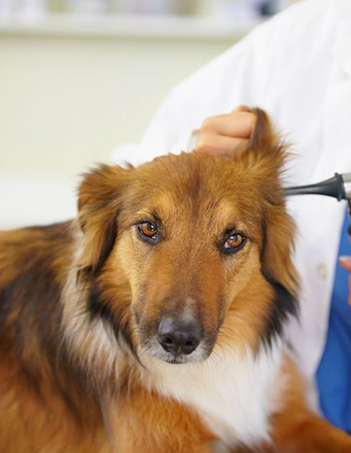Home | Surgical Info | Ear Canal Tumors in Dogs and Cats
Ear Canal Tumors in Dogs and Cats
Keywords:
Ear Canal Tumors in Dogs and Cats
At Canton Animal Hospital, we diagnose and treat a variety of benign and malignant ear canal tumors in dogs and cats. These growths can develop from the skin, ceruminous (wax-producing) glands, or deeper tissues within the ear canal. While some tumors remain localized and slow-growing, others are aggressive and can invade surrounding tissue or spread (metastasize).
Chronic inflammation is thought to be a key contributor, especially in breeds predisposed to ear infections such as German Shepherds and Cocker Spaniels. Regular ear evaluations are essential, especially for pets with persistent or recurring infections, as early detection significantly improves treatment success and quality of life. Tumors of the external and middle ear can cause persistent ear infections, pain, hearing loss, and changes in behavior. Early diagnosis and intervention are essential for improving your pet’s comfort and long-term health.
Tumors may arise from chronic inflammation, polyps that become neoplastic, or may occur spontaneously as cancerous growths. While many masses are benign, a significant number—especially in dogs—can be malignant. Common tumor types include ceruminous gland adenomas and adenocarcinomas, squamous cell carcinoma, and inflammatory polyps that undergo transformation.
Featured Resources

We Welcome New Patients!
We're always happy to give your furry friend care at our hospital. Get in touch today!
Contact Us
Common Ear Canal Tumors in Dogs and Cats
In dogs, common tumors include:
Ceruminous gland adenomas (benign)
Adenocarcinomas (malignant)
Papillomas
Sebaceous gland tumors.
In cats, the most frequently diagnosed tumors are:
Nasopharyngeal polyps
Squamous cell carcinomas
Ceruminous gland adenocarcinomas.
Signs of Ear Canal Tumors in Pets
Recurrent or chronic ear infections that do not respond to treatment
Visible mass or thickening within the ear canal
Head shaking, pawing, or scratching at the ear
Foul-smelling discharge or bleeding from the ear
Facial asymmetry, drooling, or difficulty blinking
Hearing loss or reduced responsiveness
Pain when opening the mouth or chewing

Diagnostic Evaluation
Tumors may initially be hidden by inflammation, discharge, or their deep location within the ear canal. If inflammation is present, it may need to be resolved before diagnostic sampling is possible. A combination of diagnostic tools helps determine tumor type, extent, and the best treatment approach.
Proper diagnosis involves:
Physical and otoscopic exam to inspect the ear canal
Advanced imaging (CT or radiographs) to assess tumor location and invasion
Biopsy or fine needle aspirate (FNA) to identify tumor type
Cytology or culture to rule out infection
Blood work and staging tests for suspected malignant cases
Treatment Options for Ear Tumors
The mainstay of treatment for most ear canal tumors is surgical removal, and the specific approach depends on the tumor’s location, type, and how extensively it has spread. A combination of treatments may be necessary, particularly for malignant or invasive tumors.
Surgical excision – Often curative for benign tumors. For malignant or deeply invasive tumors, a Total Ear Canal Ablation with Bulla Osteotomy (TECA-BO) may be required.
Staged mass excision – Appropriate for benign tumors that are small and located in accessible parts of the ear canal.
Laser surgery – Occasionally used for small, surface-level growths in the external ear canal.
Radiation therapy – Recommended when full surgical excision is not possible or as a follow-up for malignant tumors to reduce recurrence.
Chemotherapy – Considered in select cases where tumors are aggressive or have metastasized.
Medical management – Symptom relief, infection control, and palliative care may be used in non-surgical candidates or as supportive therapy.
Post-Operative Care and Recovery
After ear canal tumor removal, especially procedures involving TECA-BO, careful post-operative management is essential for a smooth recovery:
Hospitalization is typically 24–48 hours to monitor pain, swelling, and any immediate complications.
Pain management and anti-inflammatory medications are provided to ensure your pet remains comfortable.
Antibiotics may be prescribed if infection was present or suspected during surgery.
An Elizabethan collar is recommended to prevent self-trauma to the surgical site.
Suture removal is generally scheduled 10–14 days post-surgery.
Restricted activity is advised during the first 2–3 weeks to allow proper healing.
Follow-up appointments are important for assessing healing and identifying early signs of complications such as infection or recurrence.
Most pets adjust well post-operatively and experience significant relief from chronic symptoms. Minor side effects like temporary facial weakness or balance issues are possible but often resolve with time.
Prognosis
The prognosis for pets with ear canal tumors depends on several factors, including the type of tumor, its location, and whether it has spread.
Benign tumors such as ceruminous gland adenomas or papillomas have an excellent prognosis with complete surgical removal. These tumors typically do not recur if excised with clean margins.
Malignant tumors, such as adenocarcinomas or squamous cell carcinomas, carry a more guarded prognosis. Success depends on early detection, complete surgical excision, and whether the tumor has invaded surrounding tissue or metastasized.
Advanced cases may benefit from a combination of surgery, radiation, and/or chemotherapy. Even with aggressive treatment, the potential for recurrence or spread remains, especially if diagnosis occurs late.
Early intervention offers the best chance for successful treatment and improved quality of life.. Pets treated before the tumor causes widespread tissue damage or neurologic signs generally have a better quality of life and longer survival.
Benign tumors (e.g., ceruminous gland adenoma) generally carry a good prognosis with surgical removal.
Malignant tumors may require aggressive treatment. Prognosis depends on tumor type, invasion, and surgical margins. •
Schedule a Consultation
If your pet is showing signs of an ear tumor or persistent ear issues, contact Canton Animal Hospital for a comprehensive evaluation. Our veterinary team will assess your pet and guide you through diagnosis and treatment options.
Call us today or Request an Appointment Online to get started.
Featured Resources

We Welcome New Patients!
We're always happy to give your furry friend care at our hospital. Get in touch today!
Contact UsFrequently Asked Questions (FAQs)
Ear canal tumors can be overwhelming to navigate, especially when your pet is experiencing pain or persistent symptoms. Below are answers to some of the most common questions pet owners ask about diagnosis, treatment, and recovery.
